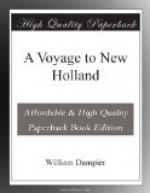Of timber-trees the sapiera is said to be large and tall; it is very good timber, and is made use of in building of houses; so is the vermiatico, a tall straight-bodied tree, of which they make plank 2 foot broad; and they also make canoes with it. Comesserie and guitteba are chiefly used in building ships; these are as much esteemed here as oaks are in England, and they say either sort is harder and more durable than oak. The serrie is a sort of tree much like elm, very durable in water. Here are also all the three sorts of mangrove trees, namely the red, the white, and the black, which I have described. The bark of the red mangrove is here used for tanning of leather, and they have great tan-pits for it. The black mangrove grows larger here than in the West Indies, and of it they make good plank. The white mangrove is larger and tougher than in the West Indies; of these they make masts and yards for barks.
The bastard-coco, its nuts and cables; and the silk-cotton-trees.
There grow here wild or bastard coconut-trees, neither so large nor so tall as the common ones in the East or West Indies. They bear nuts as the others, but not a quarter so big as the right coconuts. The shell is full of kernel, without any hollow place or water in it; and the kernel is sweet and wholesome, but very hard both for the teeth and for digestion. These nuts are in much esteem for making beads for paternosters, boles of tobacco pipes and other toys: and every small shop here has a great many of them to sell. At the top of these bastard coco-trees, among the branches, there grows a sort of long black thread-like horsehair, but much longer, which by the Portuguese is called tresabo. Of this they make cables which are very serviceable, strong and lasting; for they will not rot as cables made of hemp, though they lie exposed both to wet and heat. These are the cables which I said they keep in their harbours here, to let to hire to European ships, and resemble the coir cables.
Here are 3 sorts of cotton-trees that bear silk-cotton. One sort is such as I have formerly described by the name of the cotton-tree. The other 2 sorts I never saw anywhere but here. The trees of these latter sorts are but small in comparison of the former, which are reckoned the biggest in all the West India woods; yet are however of a good bigness and height. One of these last sorts is not so full of branches as the other of them; neither do they produce their fruit the same time of the year: for one sort had its fruit just ripe and was shedding its leaves while the other sort was yet green, and its fruit small and growing, having but newly done blossoming; the tree being as full of young fruit as an apple-tree ordinarily in England. These last yield very large pods, about 6 inches long and as big as a man’s arm. It is ripe in September and October; then the pod opens and the cotton bursts out in a great




